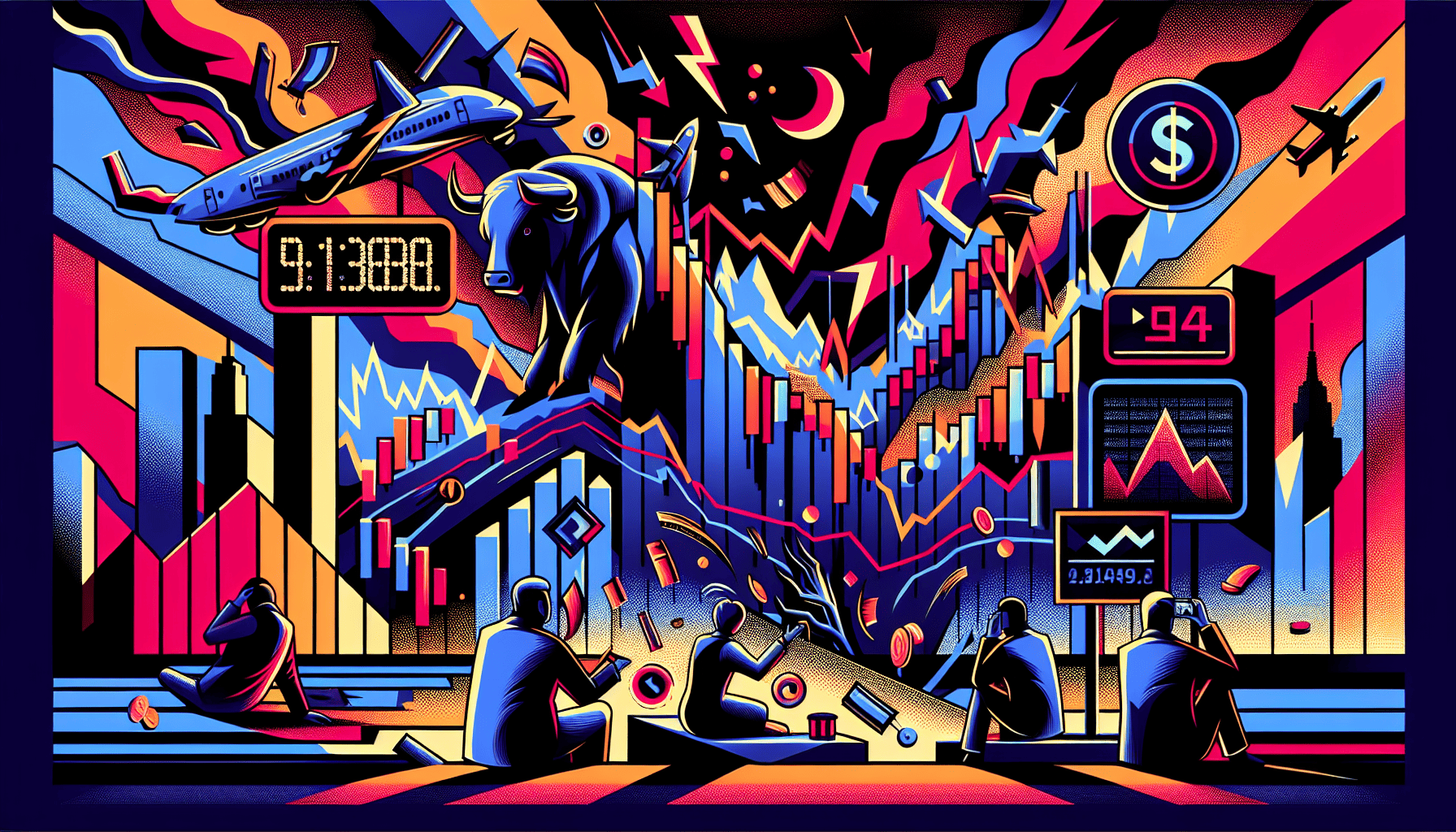Black Monday 1987: A Closer Look at the Catastrophic Stock Market Crash

Understanding Financial Market Crises
In the realm of finance, market crises are characterized by drastic downturns in asset prices, which can result in widespread economic disruption. This section provides a foundational understanding of what constitutes a financial market crisis and offers a look back at historical occurrences that have shaped the modern financial landscape.
The Anatomy of Market Crashes
Market crashes are complex events that often involve a rapid and significant decline in asset prices within a short period. A number of factors can contribute to these crashes, including economic indicators, market sentiment, technological impacts on trading, and government policies. Each crash, while unique in its specifics, tends to follow a pattern of investor behavior characterized by speculative excess followed by panic selling.
During a crash, the value of investments can plummet, eroding wealth and shaking investor confidence. This can lead to a vicious cycle as falling prices trigger more selling, further depressing prices and market sentiment. The effects of a crash can extend beyond the financial markets, impacting the broader economy by tightening credit, reducing consumer spending, and slowing down economic growth.
Historical Perspective on Crises
Throughout history, the financial markets have experienced a number of significant crises, each with its own causes and consequences. One of the most notable is Black Monday 1987: the stock market crash, when the Dow Jones Industrial Average fell by an unprecedented 22.61% in a single day. The global nature of this crash, with stock markets from Hong Kong to the United Kingdom experiencing severe losses, underscores the interconnectedness of global financial markets and the potential for rapid cross-border contagion (Corporate Finance Institute).
Other notable crises include the Great Depression, the oil crisis of 1973, the Asian financial crisis of 1997, the dot-com bubble burst of 2000, and the 2008 global financial crisis. Each of these events provides valuable lessons about the vulnerabilities and resilience of financial markets.
The historical perspective on crises is crucial for understanding the potential triggers and impacts of market crashes. By studying past events, investors and regulators can identify patterns and warning signs that may help in preventing future crises or at least mitigating their effects.
For beginner investors, gaining insight into the dynamics of financial market crises and their underlying causes is essential. It equips them with the knowledge to navigate the markets more prudently and to understand the importance of risk management and diversification in their investment strategies. To delve deeper into the intricacies of financial crises, readers can explore an overview of financial market crises and learn about the role of derivatives in financial crises.
The Infamous Black Monday
Black Monday is a term synonymous with the catastrophic stock market crash that occurred on October 19, 1987. It represents one of the most severe market downturns in financial history, leaving an indelible mark on the psyche of investors and regulators alike.
A Global Shockwave
The crash sent a global shockwave, with losses estimated at US$1.71 trillion worldwide, impacting markets from the United States to Hong Kong, Australia, Spain, the United Kingdom, and many more (Wikipedia). The Dow Jones Industrial Average (DJIA) fell by an unprecedented 22.61%, a record that still stands as the largest single-day percentage drop in history (Corporate Finance Institute).
This table reflects the impact of Black Monday on different markets:
| Market | Percentage Drop |
|---|---|
| Dow Jones Industrial Average (DJIA) | 22.61% |
| FTSE 100 (UK) | 10.84% |
| Hang Seng Index (Hong Kong) | 45.5% (in the following week) |
The repercussions of the crash echoed across the globe, leading to fears of a potential economic downturn comparable to the Great Depression. It caused a significant reevaluation of financial practices and the future of financial crisis management.
The Mechanics of the Crash
While the precise mechanics of the crash are complex, certain factors were pivotal in its onset. Initially, there was apprehension that stocks were overvalued and due for a correction. The nervousness was compounded by persistent US trade and budget deficits, increasing interest rates, the decline of the dollar’s value, and growing skepticism regarding the effectiveness of government attempts to stabilize the currency’s decline (Wikipedia).
The crash may have been further fueled by:
- The decline of the dollar and waning confidence in government interventions.
- Doubts about the efficacy of monetary policy coordination initiatives like the Louvre Accord.
- Portfolio insurance hedging strategies that may have exacerbated selling pressures.
- A contagion effect, where panic and fear fed on themselves to drive market sell-offs.
With a record 604 million shares traded on the New York Stock Exchange on that day, the market’s infrastructure struggled to cope with the volume, leading to a liquidity crisis and runaway selling (Corporate Finance Institute).
In the wake of Black Monday, significant regulatory changes were introduced, including the implementation of circuit breakers designed to halt trading and prevent a recurrence of such drastic market declines. These changes aimed to bolster market stability and curb panic selling (Investopedia).
For additional information on the causes and effects of market crises, readers might explore the overview of financial market crises or delve into specific events such as the great depression: causes and consequences and the 2008 global financial crisis: an analysis.
Underlying Causes of Market Crashes
Financial market crashes are complex events influenced by an interplay of various factors. Understanding the underlying causes can help investors and policymakers develop strategies to mitigate the risks of future crises. This section examines the economic indicators, government policies, and technological impacts that contribute to market crashes, with a focus on the infamous Black Monday of 1987.
Economic Indicators and Market Sentiment
On Black Monday, October 19, 1987, the stock market experienced an unprecedented crash, with the Dow Jones Industrial Average (DJIA) plummeting by 22.6% in a single day. Economic indicators such as overvaluation of stocks, persistent US trade and budget deficits, and rising interest rates played a significant role in the initial sell-off. A decline in the dollar’s value further contributed to investor nervousness about the market being due for a correction (Wikipedia).
| Economic Indicator | Status Pre-Crash |
|---|---|
| Stock Valuation | Overvalued |
| Trade Deficit | Persistent |
| Interest Rates | Rising |
| Dollar Value | Declining |
Market sentiment was also affected by doubts about the effectiveness of governmental attempts to stabilize the dollar and the perceived lack of coordination in monetary policy, as evidenced by initiatives like the Louvre Accord. These factors created an atmosphere of uncertainty and fear, leading to a self-reinforcing contagion that exacerbated the crash (Wikipedia).
The Role of Government Policies
Government policies have a profound impact on financial markets, and this was evident during Black Monday. The US, West Germany, and Japan’s central banks intervened by providing liquidity to prevent debt defaults, which helped limit the impacts on the real economy. In contrast, New Zealand’s Reserve Bank refrained from loosening monetary policy, resulting in more severe and long-term consequences for both its financial markets and the real economy (Wikipedia).
The response of central banks to the crash highlighted the importance of government intervention during market crises. The Federal Reserve’s actions to stabilize financial markets post-crash are often cited as a textbook example of how central banks can help restore investor confidence and prevent a market meltdown from turning into an economic disaster (Federal Reserve).
Technological Impacts on Trading
The 1987 crash was one of the first market crises where technology played a significant role. The widespread use of portfolio insurance trading strategies and computerized trading systems were key factors in the crash. These automated systems, designed to execute large volumes of trades rapidly, overwhelmed the market’s ability to maintain liquidity (Federal Reserve). The lack of liquidity caused stock prices to plummet as sell orders went unmatched.
Furthermore, Black Monday disrupted the arbitrage between stock index futures and underlying stocks, leading to a rapid unwinding of positions in the derivatives markets. This event prompted regulators to adopt new measures such as circuit breakers, which temporarily halt trading during times of extreme volatility to prevent panic-selling (Investopedia).
The technological impacts on trading are a critical area of focus for preventing future crashes. Understanding the role of automated trading systems and their potential effects on market stability is essential for developing effective regulatory safeguards.
By analyzing the economic indicators, government policies, and technological factors that contributed to market crashes like Black Monday, investors and policymakers can learn valuable lessons to build resilience in financial markets. Recognizing the warning signs and taking preemptive actions could help avert or mitigate the severity of future crises. For deeper insights into financial market crises and their management, readers can explore topics such as the 2008 global financial crisis, the role of derivatives in financial crises, and crisis prevention strategies.
The Aftermath and Responses
In the wake of the catastrophic stock market crash known as Black Monday in 1987, financial systems worldwide were left reeling. The crash not only led to a profound reassessment of market operations but also triggered a series of reforms aimed at bolstering market stability and protecting economies from future crises.
Central Banks’ Role in Stability
Central banks across the globe recognized the critical need for intervention in the aftermath of Black Monday. The Federal Reserve, under the leadership of Chairman Alan Greenspan, took decisive action by injecting liquidity into the financial system. This move was aimed at reassuring investors and stabilizing the markets, helping to prevent a deeper financial crisis.
The Fed’s response was instrumental in restoring investor confidence and has been widely regarded as a pivotal moment in central banking history. It also underscored the role of central banks as ‘lenders of last resort’ during times of financial distress.
| Action by Federal Reserve | Impact |
|---|---|
| Injecting liquidity | Helped to stabilize the financial system |
| Reassuring investors | Prevented further panic and selling |
For further reading on the role of central banks during financial crises, explore our articles on the european debt crisis explained and the 2008 global financial crisis: an analysis.
Regulatory Changes and Safeguards
The severity of Black Monday’s market plunge prompted regulators to reevaluate and strengthen financial market oversight. New policies were introduced, including the implementation of circuit breakers designed to halt trading temporarily in cases of extreme volatility, thus preventing panic selling and giving time for information to disseminate among investors (Investopedia).
Other regulatory changes focused on improving transparency and risk management. These reforms aimed to mitigate the impact of large-scale sell-offs and ensure that the market infrastructure could handle high-volume trading without significant disruptions.
| Regulatory Changes | Purpose |
|---|---|
| Circuit breakers | Prevent severe market declines |
| Transparency improvements | Enhance information flow |
| Risk management practices | Mitigate impact of sell-offs |
The global impact of Black Monday, with markets from Hong Kong to Europe suffering steep declines, highlighted the need for coordinated international regulatory efforts. This has led to ongoing collaboration among regulatory bodies to address financial contagion and cross-border effects (Federal Reserve History).
For more information on the role of regulatory failures in financial crises and the importance of international cooperation, readers may visit the role of regulatory failures in financial crises and financial contagion and cross-border effects.
These measures reinforced the financial infrastructure, equipping it to better handle the pressures that come with market turbulence. The lessons learned from Black Monday continue to influence the regulatory landscape and crisis management strategies in today’s financial markets. To delve deeper into how crises are managed and what preventative measures have been adopted since Black Monday, refer to the future of financial crisis management.
Lessons Learned from Market Turbulence
The unprecedented events of Black Monday 1987 have served as a critical learning experience for market participants and regulators, leading to significant advancements in the field of risk management and investor education.
Risk Management Evolution
Since the Black Monday 1987: the stock market crash, the financial industry has seen a marked evolution in risk management practices. One of the major shifts has been the introduction of market circuit breakers, which are regulatory measures designed to temporarily halt trading on an exchange during significant declines. These circuit breakers provide a cooling-off period to prevent panic selling and give investors time to assess the situation.
| Year | Regulation | Description |
|---|---|---|
| Post-1987 | Circuit Breakers | Implemented to prevent severe market declines |
| Ongoing | Risk Modeling | Advanced to predict potential market disruptions |
In addition to circuit breakers, there has been a greater emphasis on stress testing and scenario analysis to prepare for potential market crises. Financial institutions now regularly conduct rigorous tests to determine the resilience of their portfolios against extreme market conditions.
Improvements in risk management also include the increased use of derivatives for hedging purposes. These financial instruments allow investors to manage and transfer risk more effectively. However, they also come with their own set of challenges, which necessitates informed use and strict regulation.
The Importance of Investor Education
The aftermath of Black Monday highlighted the critical need for investor education. A well-informed investor base can make more rational decisions, which in turn contributes to market stability. Financial literacy programs have become more widespread, focusing on various aspects, from understanding market dynamics to recognizing the signs of market bubbles.
| Focus Area | Objective |
|---|---|
| Investment Types | To understand the diverse instruments available |
| Market Dynamics | To comprehend how different factors influence market movements |
| Basic Investment Strategies | To make informed decisions based on individual financial goals |
Educational resources, such as articles detailing the european debt crisis explained or the impact of speculative attacks on currencies, serve to broaden the knowledge of individuals new to investing. Moreover, historical analyses of events like the great depression: causes and consequences and the 2008 global financial crisis: an analysis provide context and lessons that can help prevent future crises.
It is crucial for investors to understand the importance of diversification and not to rely on a single asset class or market. Diversified portfolios can help mitigate the impact of market crashes on individual investors’ wealth.
By learning from past crises, including Black Monday, and continuously developing both risk management tools and educational resources, the financial markets aim to build resilience against future turbulence. For more insights on the ongoing efforts and strategies, readers can explore the future of financial crisis management and crisis prevention: lessons from past financial crises.
Building Resilience in Financial Markets
The stock market crash known as Black Monday 1987 was a wake-up call for market participants and regulators worldwide. It highlighted the need for improved mechanisms and strategies to build resilience in financial markets. Post-crash, preventative measures were implemented to mitigate the risk of future crises.
Preventative Measures Post-Crash
In the aftermath of Black Monday, regulatory bodies and market institutions took decisive action to enhance market stability and protect investors. Among the measures were the introduction of circuit breakers and trading curbs, which act as automated pauses in trading to prevent panic selling during times of extreme volatility. These circuit breakers serve as a safety net, allowing time for information dissemination and calm decision-making among investors.
| Measure | Description |
|---|---|
| Circuit Breakers | Trigger a temporary halt in trading on U.S. stock exchanges. |
| Trading Curbs | Limit the extent of price swings during a single trading session. |
Additionally, the Federal Reserve played a crucial role in providing liquidity to the financial system, reassuring the markets, and preventing a deeper financial crisis (Federal Reserve History). These initiatives, along with improved communication channels, were pivotal in restoring investor confidence.
For further insight into the central banks’ response to market crises, explore the European debt crisis explained and the 2008 global financial crisis: an analysis.
The Future of Market Crisis Management
The future of market crisis management lies in leveraging technology, enhancing regulatory frameworks, and fostering global cooperation. The evolution of computer-driven trading post-Black Monday has ushered in a new era of market volatility, necessitating the need for continuous innovation in risk management and regulatory oversight (Corporate Finance Institute).
Proactive measures such as stress testing, better risk management practices, and the implementation of robust compliance systems are key to preventing crises. Moreover, the education of investors about market dynamics and risk mitigation is crucial in fostering a more resilient marketplace.
For a comprehensive overview of financial market crises and their causes, please refer to overview of financial market crises. Additionally, lessons learned from past market turbulence can be found at crisis prevention: lessons from past financial crises.
By understanding the past and embracing preventive measures, financial markets are better equipped to handle the challenges of tomorrow. The continuous refinement of crisis management strategies and the adoption of new technologies are instrumental in safeguarding the financial ecosystem against future shocks. For an in-depth discussion on the progression of these strategies, visit the future of financial crisis management.





